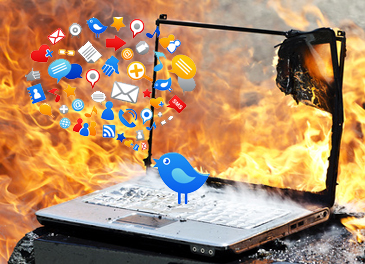Social media is an enormously powerful tool for managing customer relationships, broadcasting positive brand stories and introducing new products. But while the benefits of this free, fast and intuitive marketing channel are virtually limitless, it also has some potentially serious risks.
But there’s good news; with proper planning you can avoid the most common mistakes that lead to a social media crisis.
What Causes Social Media Crises?
Common Mistakes — Just about anything can spark social media outrage and bring out the trolls, but the most common slip-ups include:
- Spelling and grammar mistakes made by professional organizations.
- Accidentally liking an inappropriate post
- Tweeting a personal message from a professional account
- Unintentionally making an offensive statement
Serious Problems — Employee sabotage and hacking are much more serious offenses. While businesses can, and do, shift responsibility for the malicious post, they’re often criticised for allowing their login credentials to be compromised. Also, Intentionally racist, sexist, or malicious comments made by companies or individuals ignite the worst type of social media crisis.
So, how can you avoid a social media crisis? Here are 6 steps you can take.
1. Have a Crisis Communication Plan
The most important steps toward preventing a social media disaster are understanding what crisis management means for your business and creating an action plan to address your risk factors.
Since social media is your front line of communication during a crisis, your plan should include specific guidelines to protect your brand. Most importantly, always have a second set of eyes on every post before it’s published. Companies should also train more individuals in crisis communications and social media management than you think you’ll need.
2. Monitor your Social Media for Trouble!
Identifying problems as soon as they arise is critical to crisis prevention. Unfortunately, you may never know about the biggest issues facing your company because 96% of angry customers don’t complain to brands directly. Many of these upset customers prefer posting about their poor experience on their own timeline. These “dark” complaints could go unnoticed, causing negative impact, without proper tools and training.
Social listening tools allow you to monitor keywords and indirect brand mentions as well as direct mentions. This gives your company a much more holistic view of what your customers are saying across all social platforms.
3. Always Engage with Your Audience
Social profiles are frequently viewed as sales tools instead of powerful customer service platforms for building brand loyalty and customer care. By solely pitching products rather than having meaningful conversations with your followers, you could miss opportunities to address customer experience problems early on.
According to Maritz Research, 49% of customers expect companies to respond to Twitter complaints, yet only 29% of those who complained received a reply.
Additionally, customers who complain expect a response within 4 hours, while the average brand response time exceeds 10 hours.
4. Respond to Criticism Professionally
Knowing how to properly handle criticism in a public forum is essential to protecting your reputation.
Deleting comments and blocking users may seem like the quickest way to fix a problem, but doing so could cause your customer to become more outspoken. Instead, make an effort to understand what caused the situation and show a willingness to make things right.
5. Choose the Right Person to Manage Your Accounts
Assigning your brand’s social media strategy to an intern or an inexperienced employee may save you money, but it could also be a recipe for disaster.
A great social media manager has a level head, is capable of handling a crisis, and is well-organized and detail-oriented. Finding someone with public relations experience adds another layer of insurance against mistakes.
Prefer to outsource the work? At Global Media Alliance we specialize in managing social media accounts for businesses. This option may be the most impactful if you have room in your budget.
6. Draft an Employee Social Media Policy
Most people might think their private social profiles are safe for ranting about work stress, but negative posts can have serious consequences if customers or coworkers see them. Distribute guidelines about how to reference your brand online, but don’t scare your team away from posting. Happy employees are some of the best recruiting tools you can ask for!
Closing thoughts
The benefits of using social media intelligently will always outweigh the risks. Remember to monitor for problems, listen to your followers, react quickly and compassionately, and plan ahead, that way you’ll be able to maximize the benefits of this channel while avoiding potential crises.
Eli Daniel-Wilson
Head, Digital Media & Innovations
Global Media Alliance
LinkedIn: Eli Daniel-Wilson
